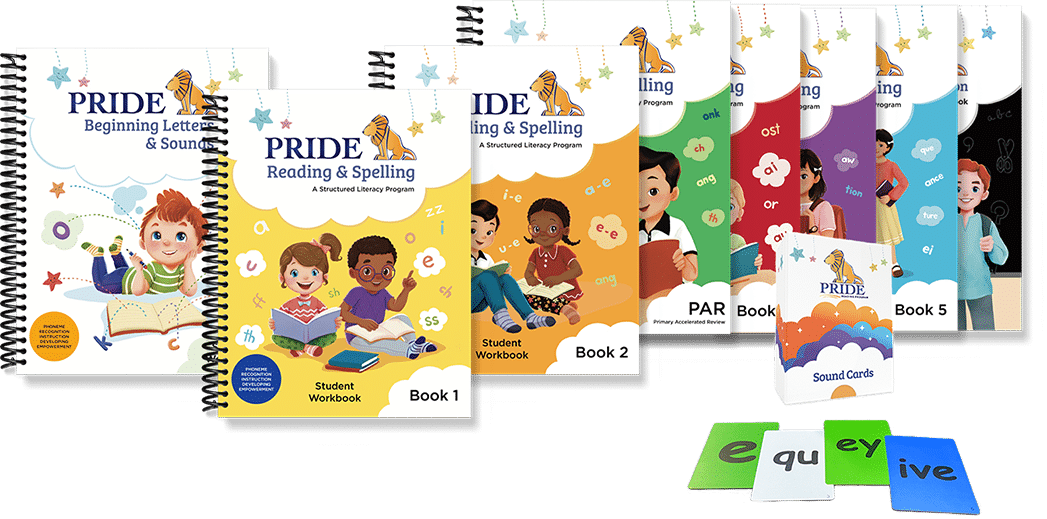If you are a homeschooling parent, you are most likely seeing the benefits of homeschooling and developing an education that meets the unique needs of your child. But what if teaching your child at home is revealing issues? What if your child is struggling with reading, avoids writing at all costs, or just can’t seem to make progress? What if it’s a learning difference like dyslexia? Here are the 10 most common Signs of Dyslexia concerned parents like you might be noticing during home learning.
1. Trouble Understanding the Connection Between Letters and Sounds
Does your child seem to have trouble recognizing letters or remembering which sound each letter in the alphabet makes? Dyslexia can cause children to take longer to grasp that a letter’s name and sound are connected, but not the same. Missing this basic building block of literacy can cause the next steps in reading to be more challenging.
2. Issues Sounding Out Single Words
Does your child sound out words incorrectly or guess words that are simple to sound out like “bat”? That’s because if you aren’t sure of the sounds letters are making, you can’t sound out a word quickly or accurately. This step goes back to not understanding the relationship between letters and sounds. Blending letters into sounds–and breaking words down into the individual sounds they are made of–can be especially tricky for a dyslexic brain.
3. Confusing Small Words
Does your child often mix up “at with “to,” “said” with “and,” or “does” with “goes”?
Many of the smallest words in English don’t follow the rules of phonics and just have to be memorized, but dyslexia creates issues with the memorization process.
4. Confusing the Order of Letters in Words
This is probably the most well-known signs of dyslexia. Consistently reading or writing words using the correct sounds–but the incorrect order–slows down reading, impairs comprehension, and makes the reading process extremely frustrating.
5. Consistent Reading and Spelling Mistakes
Keep in mind that all beginning readers make these mistakes from time to time, but pay attention to whether the mistakes seem to happen frequently, slow down reading, and/or create frustration.
Common mistakes that indicate signs of dyslexia are:
- Reversing letters like “b” and “d”
- Reversing words like “pot” and “top”
- Inverting letters like “m” and “w” or “u” and “n”
- Transposing words like “salt” and “last”
- Substituting words like “puppy” for “dog”
6. Visual Issues While Reading
Does your child complain of physical ailments when it’s time to read? Many adults assume children who complain about feeling dizzy, having a headache, or feeling nauseous while reading are making up excuses to avoid work, but these are all potential signs of dyslexia. Though visual issues do not cause dyslexia, many parents notice these signs because vision is essential to reading.
7. Handwriting Issues
Is it practically impossible to read your child’s handwriting? Do you wonder how it’s even possible to write comfortably with such a crazy grip on a pencil? Is “writing neatly” becoming a regular battle? You may not know that handwriting issues are a hallmark of dyslexia. Research suggests that poor handwriting is the direct result of being unsure of how to make a letter and/or which letter comes next in a word.
8. Trouble Getting Thoughts into Words
Is your child able to speak about any topic with fluency and enthusiasm, but that eloquence disappears during writing? Have you even noticed that your child pauses, uses “um” often, or trips over words when discussing a difficult or unfamiliar topic? Dyslexia can impair complex intellectual tasks like writing and critical communication in general.
9. Great Long Term Memory, but Trouble Remembering Facts
Does your child have no problem recalling the details of every day of the last family vacation, but seems to forget what sound “G” makes from one day to the next?
Do they never forget a face but seem to draw a blank when asked to spell a word they’ve written dozens of times?
Dyslexia can result in short-term memory issues, especially around sounds that make up words.
10. Something Just Isn’t “Clicking”
Trying to learn to read using a method that doesn’t make sense to your brain is a recipe for trouble. Dyslexia makes the process of learning how to read incredibly frustrating. This can lead to acting out when it’s time to read, having low self-esteem around reading, and trying to avoid having to read aloud–or at all.
Your child may persist in reading but never seem to make much progress, have trouble retaining new skills, or make the same mistakes no matter how much you practice. You know your child tries hard. And you know your child is bright. Something isn’t clicking, and it’s time to get to the bottom of the issue.
What To Do Next
The idea that your child may have a learning disability is daunting at any time but can be especially worrisome when your child is now learning at home with you. The good news is, dyslexia is the most common learning disability in America, and there is an established dyslexia diagnosis process you can start through your school or pediatrician. And the even better news is, dyslexic children can become strong readers using methods that make sense to their brains.
Thank you for reading my post today. You might also be interested in reading my previous posts:
Please don’t leave without checking out the PRIDE Reading Program. This program is used by teachers, tutors, and homeschooling parents worldwide with great success!


Karina Richland, M.A., is the author of the PRIDE Reading Program, a multisensory Orton-Gillingham reading, writing, and comprehension curriculum that is available worldwide for parents, tutors, teachers, and homeschoolers of struggling readers. Karina has an extensive background in working with students of all ages and various learning modalities. She has spent many years researching learning differences and differentiated teaching practices. You can reach her by email at info@pridereadingprogram.com or visit the website at www.pridereadingprogram.com

